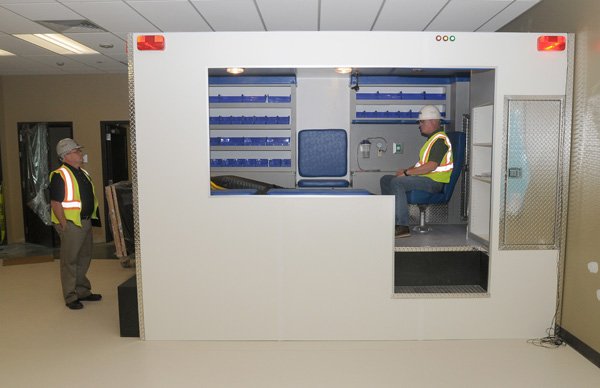NorthWest Arkansas Community College officials hope green methods used when constructing a $12.2 million building will be looked at as another way the college is teaching.
The 83,000-square-foot Center for Health Professions will open in November as the first building on campus that meets Leadership in Energy and Environmental Design standards. Classes will start there in January.
Buildings can be LEED certified if they were constructed using a set of measurable green standards outlined by the U.S. Green Building Council. A rating system ranks a building’s level of sustainability.
College officials hope to receive a silver ranking from the council. Certification is applied for following the completion of a building.
At A Glance
Health Professions
NorthWest Arkansas Community College serves an average of 1,300 health profession students a year. It will be able to increase that by 1,000 students with the new building.
The college enrolls 150 people annually in its highly competitive nursing program and turns away more than 150 applicants a year. It will be able to enroll 250 people upon the center’s completion.
Source: NorthWest Arkansas Community College
Joe Spivey, college trustee, said attaining certification sets a standard for students.
“We teach our students about green initiatives,” Spivey said. “We felt like the time was right to be a LEED institution. It can teach our students to learn green concepts and land management.”
Mark Owings, an architect with Crafton Tull, said a touch screen directory in the building lobby will detail efficient features being used.
Features include LED lighting to increase the lifespan of bulbs. An automatic lighting system will turn lights off when no one is in a room. A controlled heating and cooling system will increase and decrease temperatures around peak use hours, Owings said.
The heating and cooling system has been protected from dust and debris, Owings said. Clean air will be brought in and flushed through the system once construction is completed. The end result will mean cleaner air for those using the facility, Owings said.
Rob Dodd, project manager with Nabholz Construction, said steps were taken to limit contaminants during building.
“You will notice that you don’t smell paint or glue when walking through the building,” Dodd said.
Dodd said it is easy to see the environmental impact of the project when reviewing the amount of recycled waste.
“We have diverted 78 percent of all waste from a landfill,” Dodd said.
More than 192 tons of cardboard, metal, concrete, drywall and wood has been recycled since construction started in July 2011, Dodd said.
“We diverted 17 tons of wood and this building does not have much wood in it,” Dodd said. A majority of the wood came from crates that materials were transported in, Dodd said.
At A Glance
Rating System
The LEED rating system offers four certification levels for new construction — Certified, Silver, Gold and Platinum — that correspond to the number of credits accrued in five green design categories: sustainable sites, water efficiency, energy and atmosphere, materials and resources and indoor environmental quality. LEED standards cover new commercial construction and major renovation projects, interiors projects and existing building operations. Standards are under development to cover commercial “core & shell” construction, new home construction and neighborhood developments.
Source: www.nrdc.org/buildinggreen/leed.asp
Daniel Ellis, another Crafton Tull architect, said a bioswale will be used to filter out pollution from rainwater runoff.
The bioswale, a natural filter system made up of stones, dirt, sand and mulch, will be placed in the middle of the parking lot.
“It is for water to be held for 24 hours so it can soak into the ground slowly,” Ellis said. “This will prevent stuff from going into a stream.”
Dodd said it could take six to eight months for the college to learn if it receives a silver certification following the submittal of an application following the project’s completion.
The building will house programs for registered nurses, emergency medical technicians, fire science, respiratory therapy, paramedics, physical therapy assistants and certified nursing assistants will be housed in the building.
Mary Ross, dean of health professions, said labs designed as fully functioning emergency rooms and examination rooms will give students a realistic training experience. Wrecked cars also will be set up so paramedics and EMT students can extract “patients.”
An ambulance simulator will teach students how to load and unload patients along with an idea of how it feels to work in constricted spaces, Ross said.
“We will be able to do a lot of collaborative scenarios,” Ross said. “It can start at the scene of the event. The paramedics will be able to bring the patient into a simulated emergency room, and there our students will be able to start the treatment of that patient. We will be able to act it through like if we were at a real facility. If our students know how to do that once they get there they will be ahead of everybody else.”

